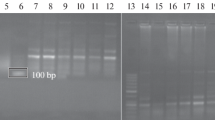Abstract
In a controlled environment, the reaction was observed of 42 bread wheat varieties and lines inoculated with 19 isolates of yellow rust differing in their virulence to 20 differential varieties. Five varieties and lines showed resistance to all isolates. The remaining ones appeared to have the genesYr2, Yr3, Yr4, Yr6, Yr7, Yr9 andYrA, either singly or in combination.Yr9 derived from rye was present in 67% of the varieties and lines.Yr4 is the only effective gene in that material as, in Eastern and Central Africa, yellow rust has virulence to the otherYr genes. Recognition of virulence toYr genes is enhanced by the use of a supplemental set of differential varieties supposedly carrying a single gene.
Samenvatting
Onder geconditioneerde klimaatsomstandigheden zijn 42 Ethiopische en CIMMYT rassen en lijnen van broodtarwe (Triticum aestivum) in het kiemplantstadium geïnoculeerd met 19 isolaten van gele roest die onderling verschilden in hun pathogeniteit voor 20 differentiërende tarwerassen waarvan de resistantie-achtergrond bekend is. De genom-gen relatie is toegepast om resistentiegenen te identificeren. Vier rassen en lijnen bleken resistent te zijn tegen alle isolaten. Verondersteld wordt dat hun resistentie berust op genen die niet eerder herkend waren of op een combinatie van bekende genen die niet compatibel was met de gebruikte isolaten. In het overige tarwemateriaal kon de aanwezigheid worden aangegeven van de resistentiegenenYr2, Yr3, Yr4, Yr6, Yr7, Yr9 enYrA. Het van rogge afkomstige en door het CIMMYT veel gebruikte resistentiegenYr9 was in 28 rassen en lijnen (67%) aanwezig. In het onderzochte tarwemateriaal isYr4 het enige voor Oost en Centraal Afrika effectieve resistentiegen omdat de daar voorkomende gele roest pathogeniteit bezit voor de overige genen. Het herkennen van pathogeniteit van gele roest voor bepaalde resistentiegenen is verbeterd door het toevoegen van tarwerassen met monogene resistentie aan het internatinale gebruikte tarwesortiment voor de determinatie van gele-roestfysio's.
Similar content being viewed by others
References
Bonthuis, H., 1985. Survival of stripe rust (Puccinia striiformis) on wheat in the Kenyan Highlands and the consequences for virulence. Mededelingen Faculteit Landbouwwetenschappen Rijks Universiteit Gent. 50 (3b): 1109–1117.
Dagnatchew Yirgou, 1967. Plant diseases of economic importance in Ethiopia. Haile Sellassie I University, Debre Zeit, Ethiopia, p. 10–11.
Dubin, H.J., Johnson, R. & Stubbs, R.W., 1989. Postulated genes for resistance to stripe rust in selected CIMMYT and related wheats. Plant Disease 73 (6): 472–475.
Eshetu Bekele, 1985. A review of research on diseases of barley, tef and wheat in Ethiopia. In: Tsedeke Abate (Ed.), A Review of Crop Protection Research in Ethiopia. Institute of Agricultural Research (IAR), Ethiopia, p. 79–107.
Getinet Gebeyehu, 1985. Effect of seeding date on grain yield of bread wheat grown at different altitudes. Regional Wheat Workshop, Njoro, Kenya, September 2–5, 1985. CIMMYT and National Plant Breeding Station, Nairobi, Kenya, p. 321–326.
Hussain, M., Gordon-Werner, E., Hetherington, S. & McIntosh, R.A., 1986. Seedling responses of Pakistani wheats to Australian rust pathotypes. In: McLean, R. (Ed.), Proceedings 5th Assembly Wheat Breeding Society Australia, Perth, p. 68–74.
Johnson, R., Stubbs, R.W., fuchs, E. & Chamberlain, N.H., 1972. Nomenclature for physiologic races ofPuccinia striiformis infecting wheat. Transactions British Mycological Society 58 (3): 475–480.
Macer, R.C.F., 1975. Presidential address: Plant pathology in a changing world. Transactions British Mycological Society 65: 351–374.
Lupton, F.G.H. & Macer, R.C.F., 1962. Inheritance of resistance to yellow rustPuccinia glumarum Erikss. and Henn. in seven varieties of wheat. Transaction British Mycological Society 45: 21–45.
McNeal, F.H., Konzak, C.S., Smith, E.P., Tate, W.S. & Russel, T.S., 1971. A uniform system for recording and processing cereal data. USDA, ARS Bulletin 34–121. 42 pp.
Mozgovoy, A.R., 1987. Stripe rust of wheat: problems, situation in Ethiopia and practical recommendation. Wheat Rust Diseases Workshop. Scientific Phytopathological Laboratory, Ambo, Ethiopia, May 11–14, 1987, p. 39–77.
Person, C., 1959. Gene-for gene relationships in host: parasite systems. Canadian Journal of Botany 37: 1101–1130.
Perwaiz, M.S. & Johnson, R., 1986. Genes for resistance to yellow rust in seedlings of wheat cultivars from Pakistan tested with British isolate ofPuccinia striiformis. Plant Breeding 97: 289–296.
Rajaram, S., Mann, Ch.E., Ortiz-Ferrara, G. & Mujeeb-Kazi, A., 1983. Adaptation, stability and high yield potential of certain 1B/1R CIMMYT wheats. Proceedings 6th International Wheat Genetics Symposium, Kyoto, Japan, p. 613–621.
Schafer, J.F. & Roelfs, A.P., 1985. Estimated relation between numbers of urediniospores ofPuccinia graminis f.sp.tritici and rates of occurrence of virulence. Phytopathology 75 (7): 749–750.
Singh, H. & Johnson, R., 1988. Genetics of resistance to yellow rust in Heines VII, Soissonais & Kalyansona. Proceedings Seventh International Wheat Genetics Symposium, Cambridge, England, 1988, p. 885–890.
Stubbs, R.W., 1985. Stripe rust. In: Roelfs, A.P. & Bushnell, W.R. (Eds.), the Cereal Rusts. II. Diseases, distribution, epidemiology and control. Academic Press, New York, p. 61–101.
Stubbs, R.W., 1988. Pathogenicity analyses of yellow (stripe) rust of wheat and its significance in a global context. In: Simmonds, N.W. & Rajaram, S. (Eds), Breeding strategies for resistance to the rusts of wheat. CIMMYT, Mexico, p. 23–38.
Van Ginkel, M., Getinet Gebeyehu & Tesfaye Tesemma, 1989. Stripe, stem and leaf rust in some major wheat producing areas in Ethiopia in 1987. IAR Newsletter of Agricultural Research 3 (4): 6–8.
Villareal, R. & Rajaram, S., 1988. Semi Dwarf Bread Wheats. Names; Parentage; Pedigrees; Origin. CIMMYT, Mexico, 42 pp.
Wellings, C.R., 1988. Pathotype evolution ofPuccinia striiformis f.sp.tritici in Eastern Australia and New Zealand. In: Zwatz, B. (Ed.), Proceedings Seventh European and Mediterranean Cereal Rusts Conference, Vienna/Austria, September 5 to 9, 1988. p. 135–136.
Zadoks, J.C., 1961. Yellow rust on wheat. Studies in epidemiology and physiologic specialization. Tijdschrift over Planteziekten 67: 69–256.
Author information
Authors and Affiliations
Rights and permissions
About this article
Cite this article
Badebo, A., Stubbs, R.W., van Ginkel, M. et al. Identification of resistance genes to Puccinia striiformis in seedlings of Ethiopian and CIMMYT bread wheat varieties and lines. Netherlands Journal of Plant Pathology 96, 199–210 (1990). https://doi.org/10.1007/BF01974257
Accepted:
Issue Date:
DOI: https://doi.org/10.1007/BF01974257




